Robotics' Impact on Job Markets: Identifying Vulnerable Industries
VerifiedAdded on 2023/01/10
|10
|3516
|52
Essay
AI Summary
This essay explores the profound impact of robotics on the job market, focusing on identifying industries and commerce sectors most vulnerable to automation and technological advancements. The essay delves into the potential for job displacement, highlighting the shift in required skills and the emergence of new job categories. It examines the advantages and disadvantages of robotics, considering both increased productivity and potential unemployment issues. Furthermore, the essay analyzes the role of government in planning for this technological shift, discussing attainable measures and ethical and institutional policies that could mitigate the negative impacts and foster a smooth transition for the workforce. The analysis considers various demographic criteria, such as education, gender, age, and race, to understand how different groups may be affected by the rise of robotics and artificial intelligence. The essay also provides a critical evaluation of the potential benefits and drawbacks of robotics across diverse sectors, including manufacturing, healthcare, finance, and education. The essay concludes by emphasizing the need for proactive government strategies to address the challenges and opportunities presented by robotics, ensuring a sustainable and equitable future for all.
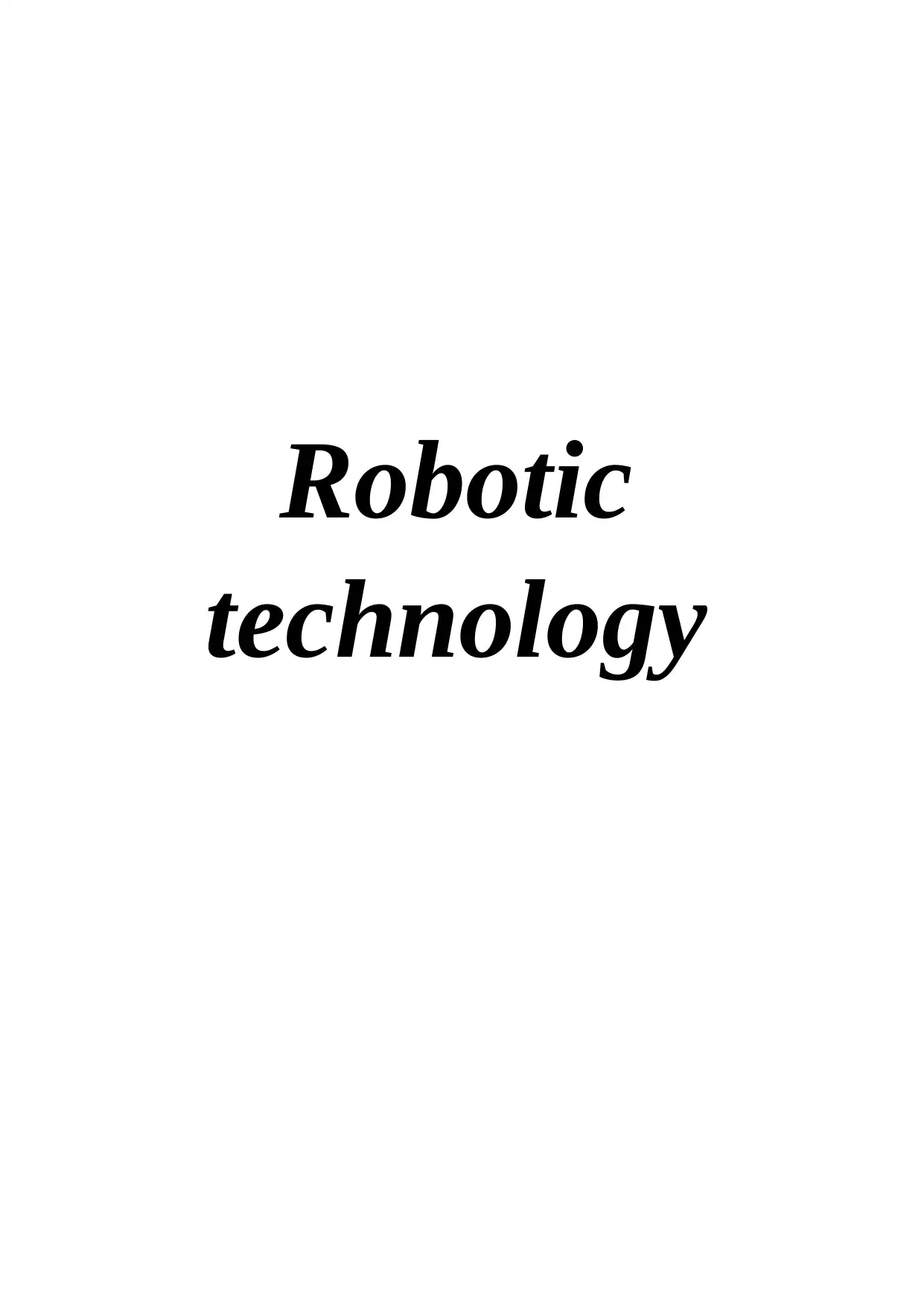
Robotic
technology
technology
Paraphrase This Document
Need a fresh take? Get an instant paraphrase of this document with our AI Paraphraser

Topic - Robotics is going to make a huge difference to people's job prospects; identify the areas of
industry and commerce which are most at risk and discuss what, if anything, governments can do to
plan for this............................................................................................................................................3
ESSAY..................................................................................................................................................3
REFERENCES..................................................................................................................................10
industry and commerce which are most at risk and discuss what, if anything, governments can do to
plan for this............................................................................................................................................3
ESSAY..................................................................................................................................................3
REFERENCES..................................................................................................................................10
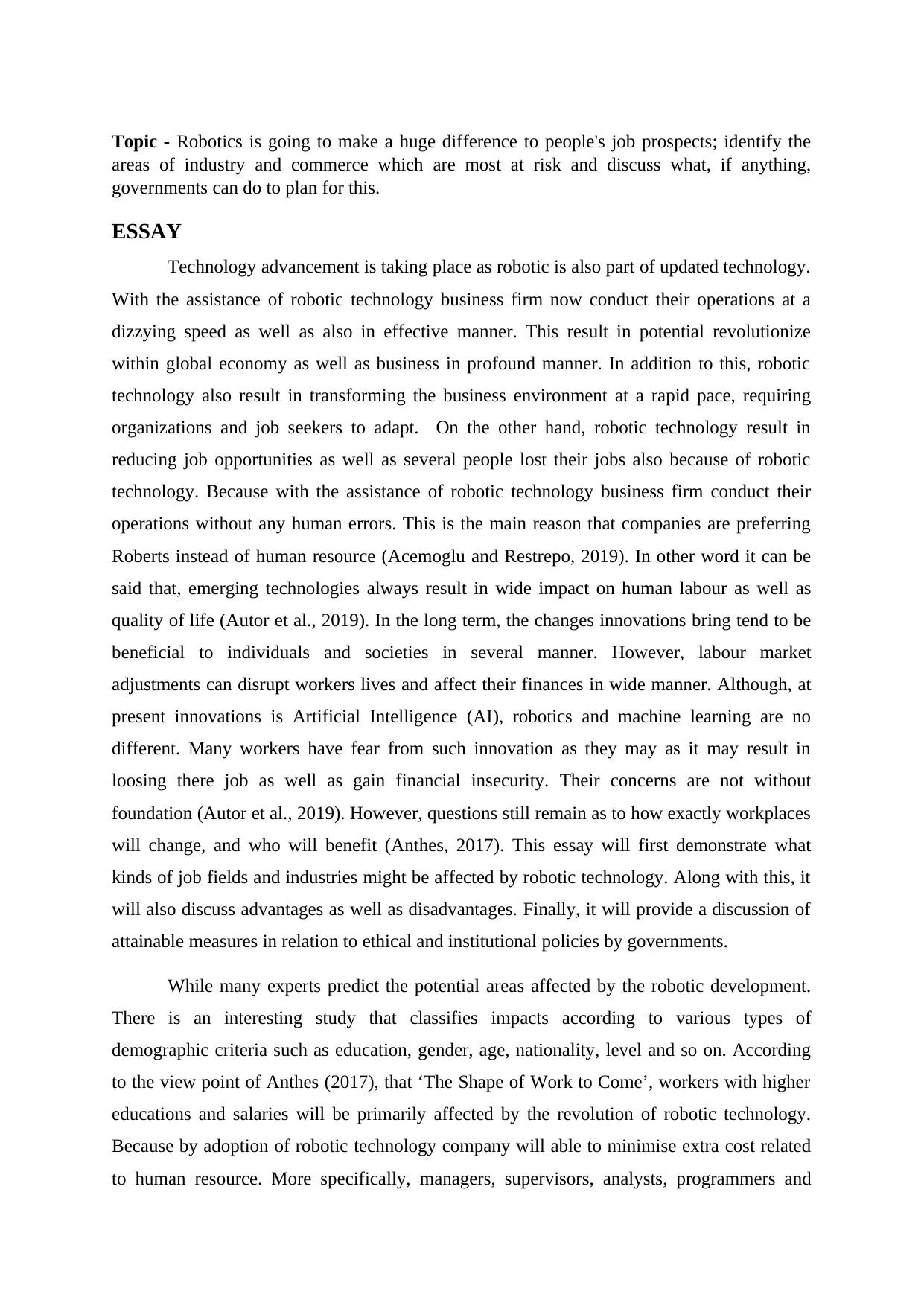
Topic - Robotics is going to make a huge difference to people's job prospects; identify the
areas of industry and commerce which are most at risk and discuss what, if anything,
governments can do to plan for this.
ESSAY
Technology advancement is taking place as robotic is also part of updated technology.
With the assistance of robotic technology business firm now conduct their operations at a
dizzying speed as well as also in effective manner. This result in potential revolutionize
within global economy as well as business in profound manner. In addition to this, robotic
technology also result in transforming the business environment at a rapid pace, requiring
organizations and job seekers to adapt. On the other hand, robotic technology result in
reducing job opportunities as well as several people lost their jobs also because of robotic
technology. Because with the assistance of robotic technology business firm conduct their
operations without any human errors. This is the main reason that companies are preferring
Roberts instead of human resource (Acemoglu and Restrepo, 2019). In other word it can be
said that, emerging technologies always result in wide impact on human labour as well as
quality of life (Autor et al., 2019). In the long term, the changes innovations bring tend to be
beneficial to individuals and societies in several manner. However, labour market
adjustments can disrupt workers lives and affect their finances in wide manner. Although, at
present innovations is Artificial Intelligence (AI), robotics and machine learning are no
different. Many workers have fear from such innovation as they may as it may result in
loosing there job as well as gain financial insecurity. Their concerns are not without
foundation (Autor et al., 2019). However, questions still remain as to how exactly workplaces
will change, and who will benefit (Anthes, 2017). This essay will first demonstrate what
kinds of job fields and industries might be affected by robotic technology. Along with this, it
will also discuss advantages as well as disadvantages. Finally, it will provide a discussion of
attainable measures in relation to ethical and institutional policies by governments.
While many experts predict the potential areas affected by the robotic development.
There is an interesting study that classifies impacts according to various types of
demographic criteria such as education, gender, age, nationality, level and so on. According
to the view point of Anthes (2017), that ‘The Shape of Work to Come’, workers with higher
educations and salaries will be primarily affected by the revolution of robotic technology.
Because by adoption of robotic technology company will able to minimise extra cost related
to human resource. More specifically, managers, supervisors, analysts, programmers and
areas of industry and commerce which are most at risk and discuss what, if anything,
governments can do to plan for this.
ESSAY
Technology advancement is taking place as robotic is also part of updated technology.
With the assistance of robotic technology business firm now conduct their operations at a
dizzying speed as well as also in effective manner. This result in potential revolutionize
within global economy as well as business in profound manner. In addition to this, robotic
technology also result in transforming the business environment at a rapid pace, requiring
organizations and job seekers to adapt. On the other hand, robotic technology result in
reducing job opportunities as well as several people lost their jobs also because of robotic
technology. Because with the assistance of robotic technology business firm conduct their
operations without any human errors. This is the main reason that companies are preferring
Roberts instead of human resource (Acemoglu and Restrepo, 2019). In other word it can be
said that, emerging technologies always result in wide impact on human labour as well as
quality of life (Autor et al., 2019). In the long term, the changes innovations bring tend to be
beneficial to individuals and societies in several manner. However, labour market
adjustments can disrupt workers lives and affect their finances in wide manner. Although, at
present innovations is Artificial Intelligence (AI), robotics and machine learning are no
different. Many workers have fear from such innovation as they may as it may result in
loosing there job as well as gain financial insecurity. Their concerns are not without
foundation (Autor et al., 2019). However, questions still remain as to how exactly workplaces
will change, and who will benefit (Anthes, 2017). This essay will first demonstrate what
kinds of job fields and industries might be affected by robotic technology. Along with this, it
will also discuss advantages as well as disadvantages. Finally, it will provide a discussion of
attainable measures in relation to ethical and institutional policies by governments.
While many experts predict the potential areas affected by the robotic development.
There is an interesting study that classifies impacts according to various types of
demographic criteria such as education, gender, age, nationality, level and so on. According
to the view point of Anthes (2017), that ‘The Shape of Work to Come’, workers with higher
educations and salaries will be primarily affected by the revolution of robotic technology.
Because by adoption of robotic technology company will able to minimise extra cost related
to human resource. More specifically, managers, supervisors, analysts, programmers and
You're viewing a preview
Unlock full access by subscribing today!
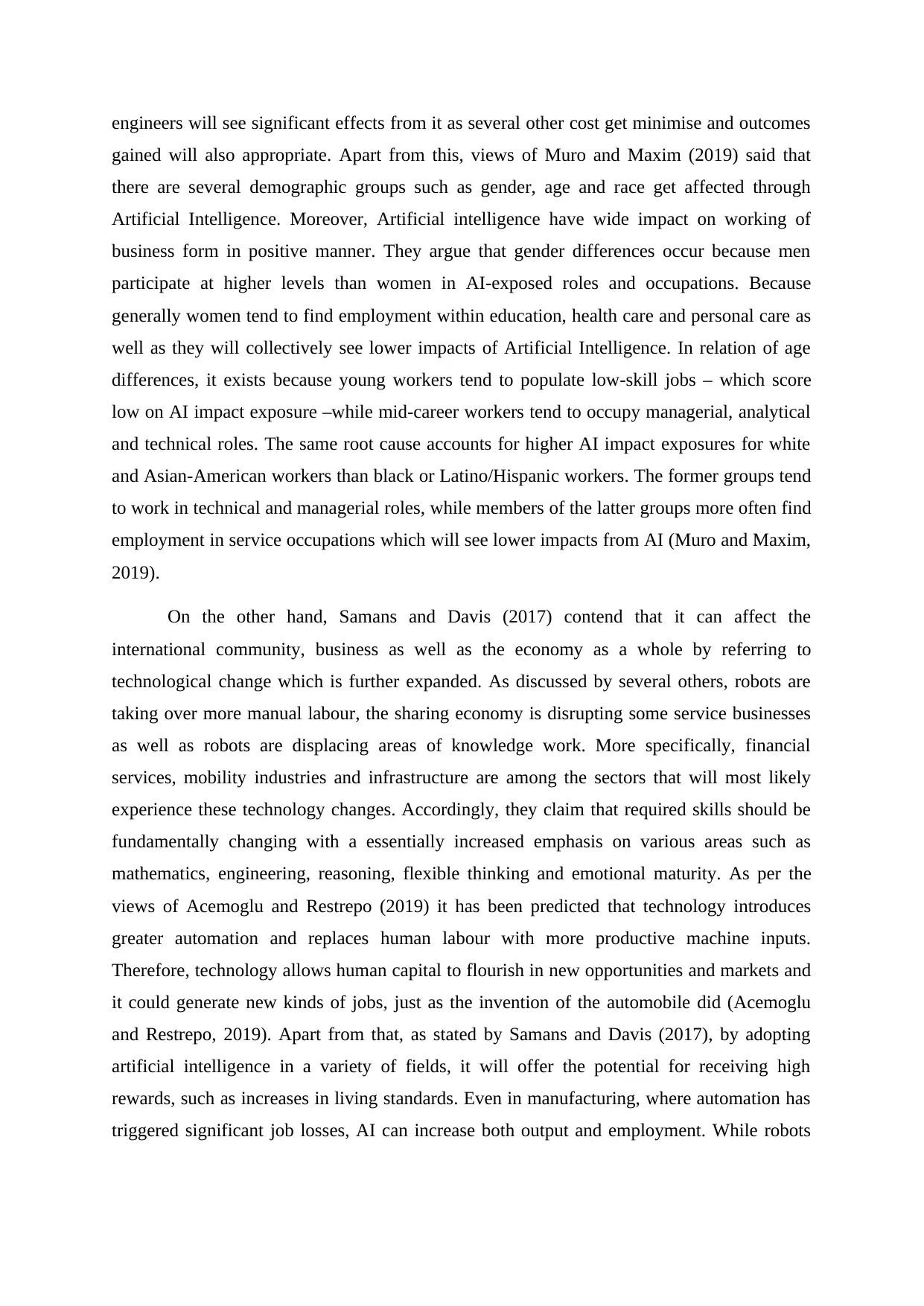
engineers will see significant effects from it as several other cost get minimise and outcomes
gained will also appropriate. Apart from this, views of Muro and Maxim (2019) said that
there are several demographic groups such as gender, age and race get affected through
Artificial Intelligence. Moreover, Artificial intelligence have wide impact on working of
business form in positive manner. They argue that gender differences occur because men
participate at higher levels than women in AI-exposed roles and occupations. Because
generally women tend to find employment within education, health care and personal care as
well as they will collectively see lower impacts of Artificial Intelligence. In relation of age
differences, it exists because young workers tend to populate low-skill jobs – which score
low on AI impact exposure –while mid-career workers tend to occupy managerial, analytical
and technical roles. The same root cause accounts for higher AI impact exposures for white
and Asian-American workers than black or Latino/Hispanic workers. The former groups tend
to work in technical and managerial roles, while members of the latter groups more often find
employment in service occupations which will see lower impacts from AI (Muro and Maxim,
2019).
On the other hand, Samans and Davis (2017) contend that it can affect the
international community, business as well as the economy as a whole by referring to
technological change which is further expanded. As discussed by several others, robots are
taking over more manual labour, the sharing economy is disrupting some service businesses
as well as robots are displacing areas of knowledge work. More specifically, financial
services, mobility industries and infrastructure are among the sectors that will most likely
experience these technology changes. Accordingly, they claim that required skills should be
fundamentally changing with a essentially increased emphasis on various areas such as
mathematics, engineering, reasoning, flexible thinking and emotional maturity. As per the
views of Acemoglu and Restrepo (2019) it has been predicted that technology introduces
greater automation and replaces human labour with more productive machine inputs.
Therefore, technology allows human capital to flourish in new opportunities and markets and
it could generate new kinds of jobs, just as the invention of the automobile did (Acemoglu
and Restrepo, 2019). Apart from that, as stated by Samans and Davis (2017), by adopting
artificial intelligence in a variety of fields, it will offer the potential for receiving high
rewards, such as increases in living standards. Even in manufacturing, where automation has
triggered significant job losses, AI can increase both output and employment. While robots
gained will also appropriate. Apart from this, views of Muro and Maxim (2019) said that
there are several demographic groups such as gender, age and race get affected through
Artificial Intelligence. Moreover, Artificial intelligence have wide impact on working of
business form in positive manner. They argue that gender differences occur because men
participate at higher levels than women in AI-exposed roles and occupations. Because
generally women tend to find employment within education, health care and personal care as
well as they will collectively see lower impacts of Artificial Intelligence. In relation of age
differences, it exists because young workers tend to populate low-skill jobs – which score
low on AI impact exposure –while mid-career workers tend to occupy managerial, analytical
and technical roles. The same root cause accounts for higher AI impact exposures for white
and Asian-American workers than black or Latino/Hispanic workers. The former groups tend
to work in technical and managerial roles, while members of the latter groups more often find
employment in service occupations which will see lower impacts from AI (Muro and Maxim,
2019).
On the other hand, Samans and Davis (2017) contend that it can affect the
international community, business as well as the economy as a whole by referring to
technological change which is further expanded. As discussed by several others, robots are
taking over more manual labour, the sharing economy is disrupting some service businesses
as well as robots are displacing areas of knowledge work. More specifically, financial
services, mobility industries and infrastructure are among the sectors that will most likely
experience these technology changes. Accordingly, they claim that required skills should be
fundamentally changing with a essentially increased emphasis on various areas such as
mathematics, engineering, reasoning, flexible thinking and emotional maturity. As per the
views of Acemoglu and Restrepo (2019) it has been predicted that technology introduces
greater automation and replaces human labour with more productive machine inputs.
Therefore, technology allows human capital to flourish in new opportunities and markets and
it could generate new kinds of jobs, just as the invention of the automobile did (Acemoglu
and Restrepo, 2019). Apart from that, as stated by Samans and Davis (2017), by adopting
artificial intelligence in a variety of fields, it will offer the potential for receiving high
rewards, such as increases in living standards. Even in manufacturing, where automation has
triggered significant job losses, AI can increase both output and employment. While robots
Paraphrase This Document
Need a fresh take? Get an instant paraphrase of this document with our AI Paraphraser
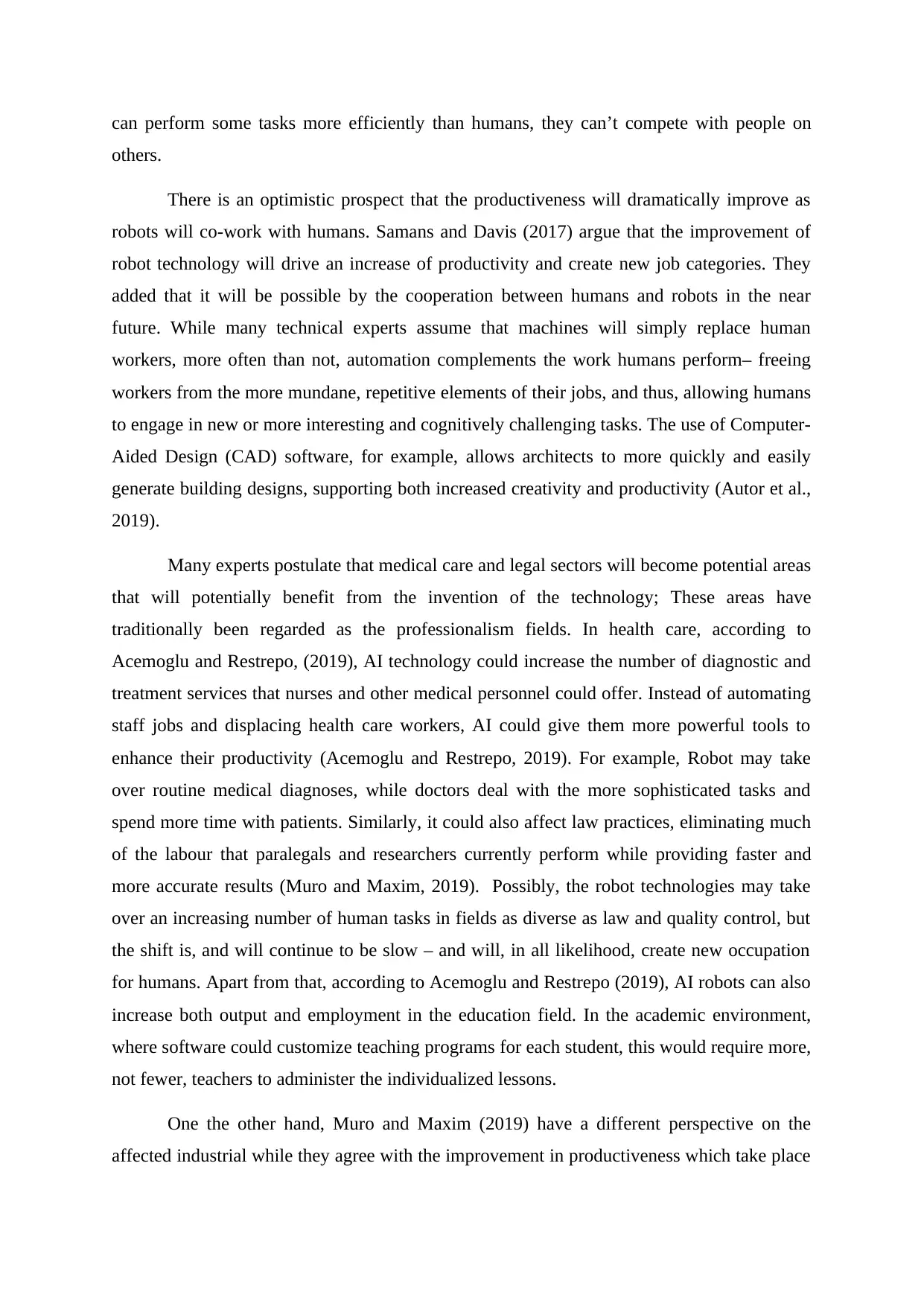
can perform some tasks more efficiently than humans, they can’t compete with people on
others.
There is an optimistic prospect that the productiveness will dramatically improve as
robots will co-work with humans. Samans and Davis (2017) argue that the improvement of
robot technology will drive an increase of productivity and create new job categories. They
added that it will be possible by the cooperation between humans and robots in the near
future. While many technical experts assume that machines will simply replace human
workers, more often than not, automation complements the work humans perform– freeing
workers from the more mundane, repetitive elements of their jobs, and thus, allowing humans
to engage in new or more interesting and cognitively challenging tasks. The use of Computer-
Aided Design (CAD) software, for example, allows architects to more quickly and easily
generate building designs, supporting both increased creativity and productivity (Autor et al.,
2019).
Many experts postulate that medical care and legal sectors will become potential areas
that will potentially benefit from the invention of the technology; These areas have
traditionally been regarded as the professionalism fields. In health care, according to
Acemoglu and Restrepo, (2019), AI technology could increase the number of diagnostic and
treatment services that nurses and other medical personnel could offer. Instead of automating
staff jobs and displacing health care workers, AI could give them more powerful tools to
enhance their productivity (Acemoglu and Restrepo, 2019). For example, Robot may take
over routine medical diagnoses, while doctors deal with the more sophisticated tasks and
spend more time with patients. Similarly, it could also affect law practices, eliminating much
of the labour that paralegals and researchers currently perform while providing faster and
more accurate results (Muro and Maxim, 2019). Possibly, the robot technologies may take
over an increasing number of human tasks in fields as diverse as law and quality control, but
the shift is, and will continue to be slow – and will, in all likelihood, create new occupation
for humans. Apart from that, according to Acemoglu and Restrepo (2019), AI robots can also
increase both output and employment in the education field. In the academic environment,
where software could customize teaching programs for each student, this would require more,
not fewer, teachers to administer the individualized lessons.
One the other hand, Muro and Maxim (2019) have a different perspective on the
affected industrial while they agree with the improvement in productiveness which take place
others.
There is an optimistic prospect that the productiveness will dramatically improve as
robots will co-work with humans. Samans and Davis (2017) argue that the improvement of
robot technology will drive an increase of productivity and create new job categories. They
added that it will be possible by the cooperation between humans and robots in the near
future. While many technical experts assume that machines will simply replace human
workers, more often than not, automation complements the work humans perform– freeing
workers from the more mundane, repetitive elements of their jobs, and thus, allowing humans
to engage in new or more interesting and cognitively challenging tasks. The use of Computer-
Aided Design (CAD) software, for example, allows architects to more quickly and easily
generate building designs, supporting both increased creativity and productivity (Autor et al.,
2019).
Many experts postulate that medical care and legal sectors will become potential areas
that will potentially benefit from the invention of the technology; These areas have
traditionally been regarded as the professionalism fields. In health care, according to
Acemoglu and Restrepo, (2019), AI technology could increase the number of diagnostic and
treatment services that nurses and other medical personnel could offer. Instead of automating
staff jobs and displacing health care workers, AI could give them more powerful tools to
enhance their productivity (Acemoglu and Restrepo, 2019). For example, Robot may take
over routine medical diagnoses, while doctors deal with the more sophisticated tasks and
spend more time with patients. Similarly, it could also affect law practices, eliminating much
of the labour that paralegals and researchers currently perform while providing faster and
more accurate results (Muro and Maxim, 2019). Possibly, the robot technologies may take
over an increasing number of human tasks in fields as diverse as law and quality control, but
the shift is, and will continue to be slow – and will, in all likelihood, create new occupation
for humans. Apart from that, according to Acemoglu and Restrepo (2019), AI robots can also
increase both output and employment in the education field. In the academic environment,
where software could customize teaching programs for each student, this would require more,
not fewer, teachers to administer the individualized lessons.
One the other hand, Muro and Maxim (2019) have a different perspective on the
affected industrial while they agree with the improvement in productiveness which take place
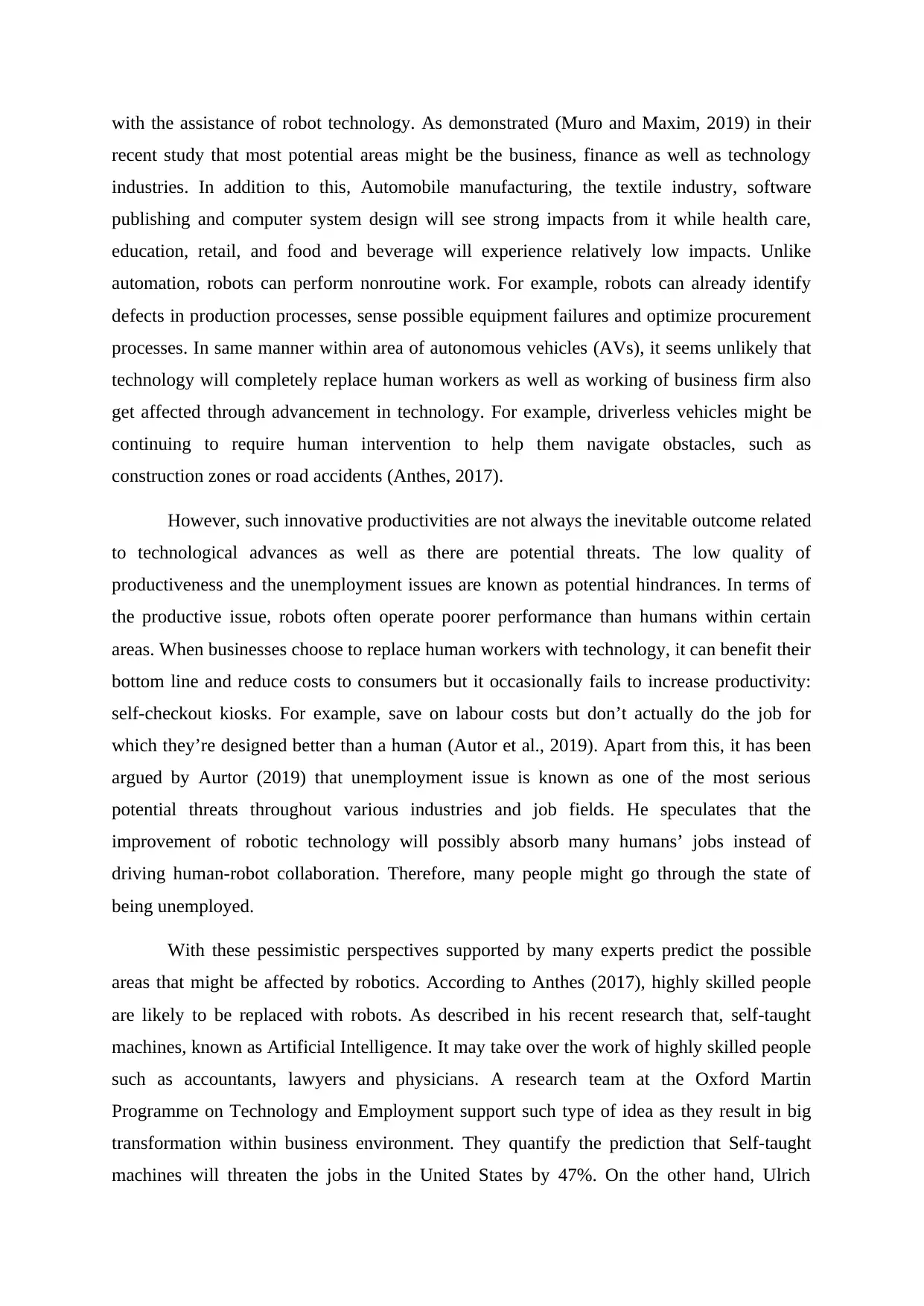
with the assistance of robot technology. As demonstrated (Muro and Maxim, 2019) in their
recent study that most potential areas might be the business, finance as well as technology
industries. In addition to this, Automobile manufacturing, the textile industry, software
publishing and computer system design will see strong impacts from it while health care,
education, retail, and food and beverage will experience relatively low impacts. Unlike
automation, robots can perform nonroutine work. For example, robots can already identify
defects in production processes, sense possible equipment failures and optimize procurement
processes. In same manner within area of autonomous vehicles (AVs), it seems unlikely that
technology will completely replace human workers as well as working of business firm also
get affected through advancement in technology. For example, driverless vehicles might be
continuing to require human intervention to help them navigate obstacles, such as
construction zones or road accidents (Anthes, 2017).
However, such innovative productivities are not always the inevitable outcome related
to technological advances as well as there are potential threats. The low quality of
productiveness and the unemployment issues are known as potential hindrances. In terms of
the productive issue, robots often operate poorer performance than humans within certain
areas. When businesses choose to replace human workers with technology, it can benefit their
bottom line and reduce costs to consumers but it occasionally fails to increase productivity:
self-checkout kiosks. For example, save on labour costs but don’t actually do the job for
which they’re designed better than a human (Autor et al., 2019). Apart from this, it has been
argued by Aurtor (2019) that unemployment issue is known as one of the most serious
potential threats throughout various industries and job fields. He speculates that the
improvement of robotic technology will possibly absorb many humans’ jobs instead of
driving human-robot collaboration. Therefore, many people might go through the state of
being unemployed.
With these pessimistic perspectives supported by many experts predict the possible
areas that might be affected by robotics. According to Anthes (2017), highly skilled people
are likely to be replaced with robots. As described in his recent research that, self-taught
machines, known as Artificial Intelligence. It may take over the work of highly skilled people
such as accountants, lawyers and physicians. A research team at the Oxford Martin
Programme on Technology and Employment support such type of idea as they result in big
transformation within business environment. They quantify the prediction that Self-taught
machines will threaten the jobs in the United States by 47%. On the other hand, Ulrich
recent study that most potential areas might be the business, finance as well as technology
industries. In addition to this, Automobile manufacturing, the textile industry, software
publishing and computer system design will see strong impacts from it while health care,
education, retail, and food and beverage will experience relatively low impacts. Unlike
automation, robots can perform nonroutine work. For example, robots can already identify
defects in production processes, sense possible equipment failures and optimize procurement
processes. In same manner within area of autonomous vehicles (AVs), it seems unlikely that
technology will completely replace human workers as well as working of business firm also
get affected through advancement in technology. For example, driverless vehicles might be
continuing to require human intervention to help them navigate obstacles, such as
construction zones or road accidents (Anthes, 2017).
However, such innovative productivities are not always the inevitable outcome related
to technological advances as well as there are potential threats. The low quality of
productiveness and the unemployment issues are known as potential hindrances. In terms of
the productive issue, robots often operate poorer performance than humans within certain
areas. When businesses choose to replace human workers with technology, it can benefit their
bottom line and reduce costs to consumers but it occasionally fails to increase productivity:
self-checkout kiosks. For example, save on labour costs but don’t actually do the job for
which they’re designed better than a human (Autor et al., 2019). Apart from this, it has been
argued by Aurtor (2019) that unemployment issue is known as one of the most serious
potential threats throughout various industries and job fields. He speculates that the
improvement of robotic technology will possibly absorb many humans’ jobs instead of
driving human-robot collaboration. Therefore, many people might go through the state of
being unemployed.
With these pessimistic perspectives supported by many experts predict the possible
areas that might be affected by robotics. According to Anthes (2017), highly skilled people
are likely to be replaced with robots. As described in his recent research that, self-taught
machines, known as Artificial Intelligence. It may take over the work of highly skilled people
such as accountants, lawyers and physicians. A research team at the Oxford Martin
Programme on Technology and Employment support such type of idea as they result in big
transformation within business environment. They quantify the prediction that Self-taught
machines will threaten the jobs in the United States by 47%. On the other hand, Ulrich
You're viewing a preview
Unlock full access by subscribing today!
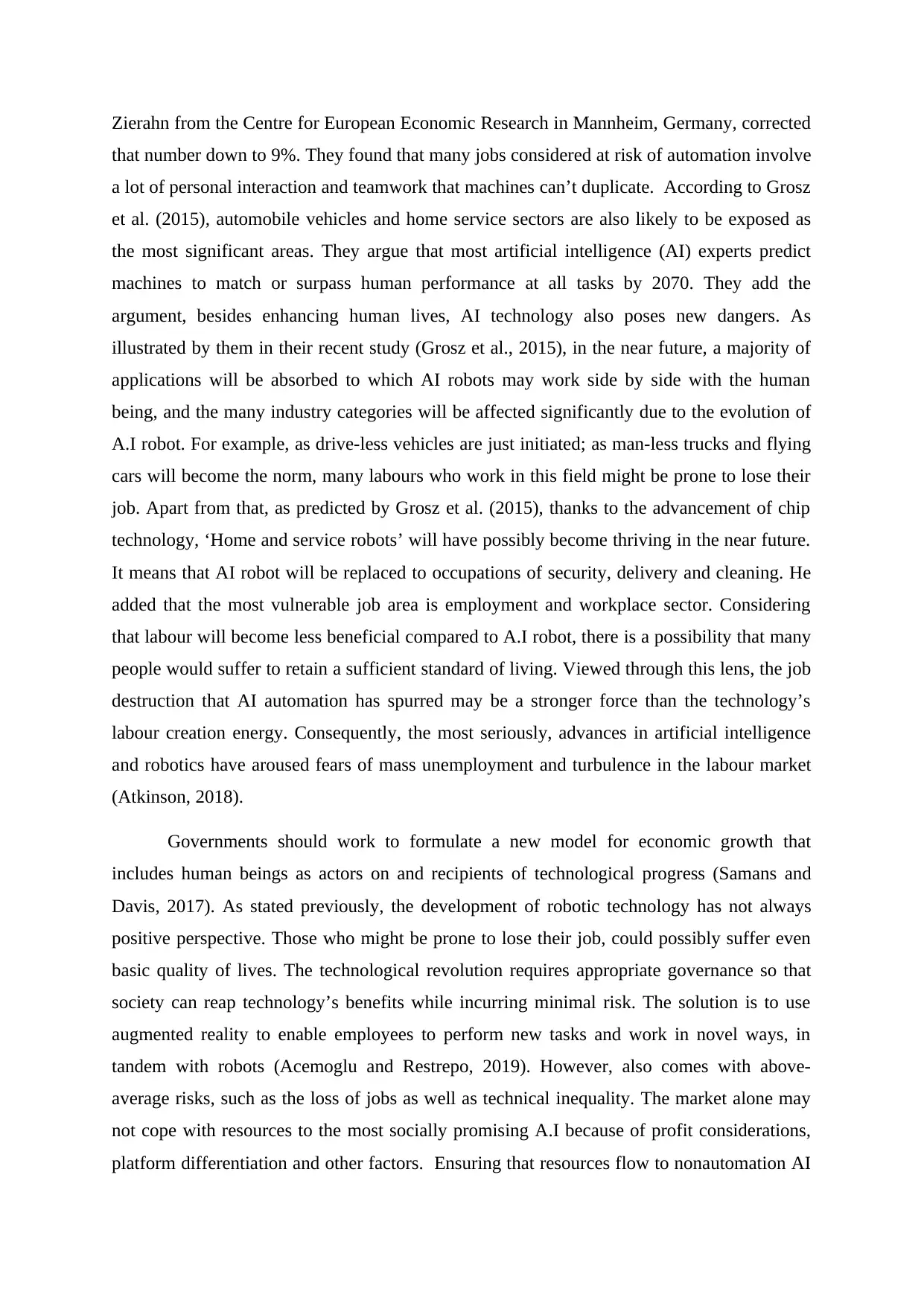
Zierahn from the Centre for European Economic Research in Mannheim, Germany, corrected
that number down to 9%. They found that many jobs considered at risk of automation involve
a lot of personal interaction and teamwork that machines can’t duplicate. According to Grosz
et al. (2015), automobile vehicles and home service sectors are also likely to be exposed as
the most significant areas. They argue that most artificial intelligence (AI) experts predict
machines to match or surpass human performance at all tasks by 2070. They add the
argument, besides enhancing human lives, AI technology also poses new dangers. As
illustrated by them in their recent study (Grosz et al., 2015), in the near future, a majority of
applications will be absorbed to which AI robots may work side by side with the human
being, and the many industry categories will be affected significantly due to the evolution of
A.I robot. For example, as drive-less vehicles are just initiated; as man-less trucks and flying
cars will become the norm, many labours who work in this field might be prone to lose their
job. Apart from that, as predicted by Grosz et al. (2015), thanks to the advancement of chip
technology, ‘Home and service robots’ will have possibly become thriving in the near future.
It means that AI robot will be replaced to occupations of security, delivery and cleaning. He
added that the most vulnerable job area is employment and workplace sector. Considering
that labour will become less beneficial compared to A.I robot, there is a possibility that many
people would suffer to retain a sufficient standard of living. Viewed through this lens, the job
destruction that AI automation has spurred may be a stronger force than the technology’s
labour creation energy. Consequently, the most seriously, advances in artificial intelligence
and robotics have aroused fears of mass unemployment and turbulence in the labour market
(Atkinson, 2018).
Governments should work to formulate a new model for economic growth that
includes human beings as actors on and recipients of technological progress (Samans and
Davis, 2017). As stated previously, the development of robotic technology has not always
positive perspective. Those who might be prone to lose their job, could possibly suffer even
basic quality of lives. The technological revolution requires appropriate governance so that
society can reap technology’s benefits while incurring minimal risk. The solution is to use
augmented reality to enable employees to perform new tasks and work in novel ways, in
tandem with robots (Acemoglu and Restrepo, 2019). However, also comes with above-
average risks, such as the loss of jobs as well as technical inequality. The market alone may
not cope with resources to the most socially promising A.I because of profit considerations,
platform differentiation and other factors. Ensuring that resources flow to nonautomation AI
that number down to 9%. They found that many jobs considered at risk of automation involve
a lot of personal interaction and teamwork that machines can’t duplicate. According to Grosz
et al. (2015), automobile vehicles and home service sectors are also likely to be exposed as
the most significant areas. They argue that most artificial intelligence (AI) experts predict
machines to match or surpass human performance at all tasks by 2070. They add the
argument, besides enhancing human lives, AI technology also poses new dangers. As
illustrated by them in their recent study (Grosz et al., 2015), in the near future, a majority of
applications will be absorbed to which AI robots may work side by side with the human
being, and the many industry categories will be affected significantly due to the evolution of
A.I robot. For example, as drive-less vehicles are just initiated; as man-less trucks and flying
cars will become the norm, many labours who work in this field might be prone to lose their
job. Apart from that, as predicted by Grosz et al. (2015), thanks to the advancement of chip
technology, ‘Home and service robots’ will have possibly become thriving in the near future.
It means that AI robot will be replaced to occupations of security, delivery and cleaning. He
added that the most vulnerable job area is employment and workplace sector. Considering
that labour will become less beneficial compared to A.I robot, there is a possibility that many
people would suffer to retain a sufficient standard of living. Viewed through this lens, the job
destruction that AI automation has spurred may be a stronger force than the technology’s
labour creation energy. Consequently, the most seriously, advances in artificial intelligence
and robotics have aroused fears of mass unemployment and turbulence in the labour market
(Atkinson, 2018).
Governments should work to formulate a new model for economic growth that
includes human beings as actors on and recipients of technological progress (Samans and
Davis, 2017). As stated previously, the development of robotic technology has not always
positive perspective. Those who might be prone to lose their job, could possibly suffer even
basic quality of lives. The technological revolution requires appropriate governance so that
society can reap technology’s benefits while incurring minimal risk. The solution is to use
augmented reality to enable employees to perform new tasks and work in novel ways, in
tandem with robots (Acemoglu and Restrepo, 2019). However, also comes with above-
average risks, such as the loss of jobs as well as technical inequality. The market alone may
not cope with resources to the most socially promising A.I because of profit considerations,
platform differentiation and other factors. Ensuring that resources flow to nonautomation AI
Paraphrase This Document
Need a fresh take? Get an instant paraphrase of this document with our AI Paraphraser
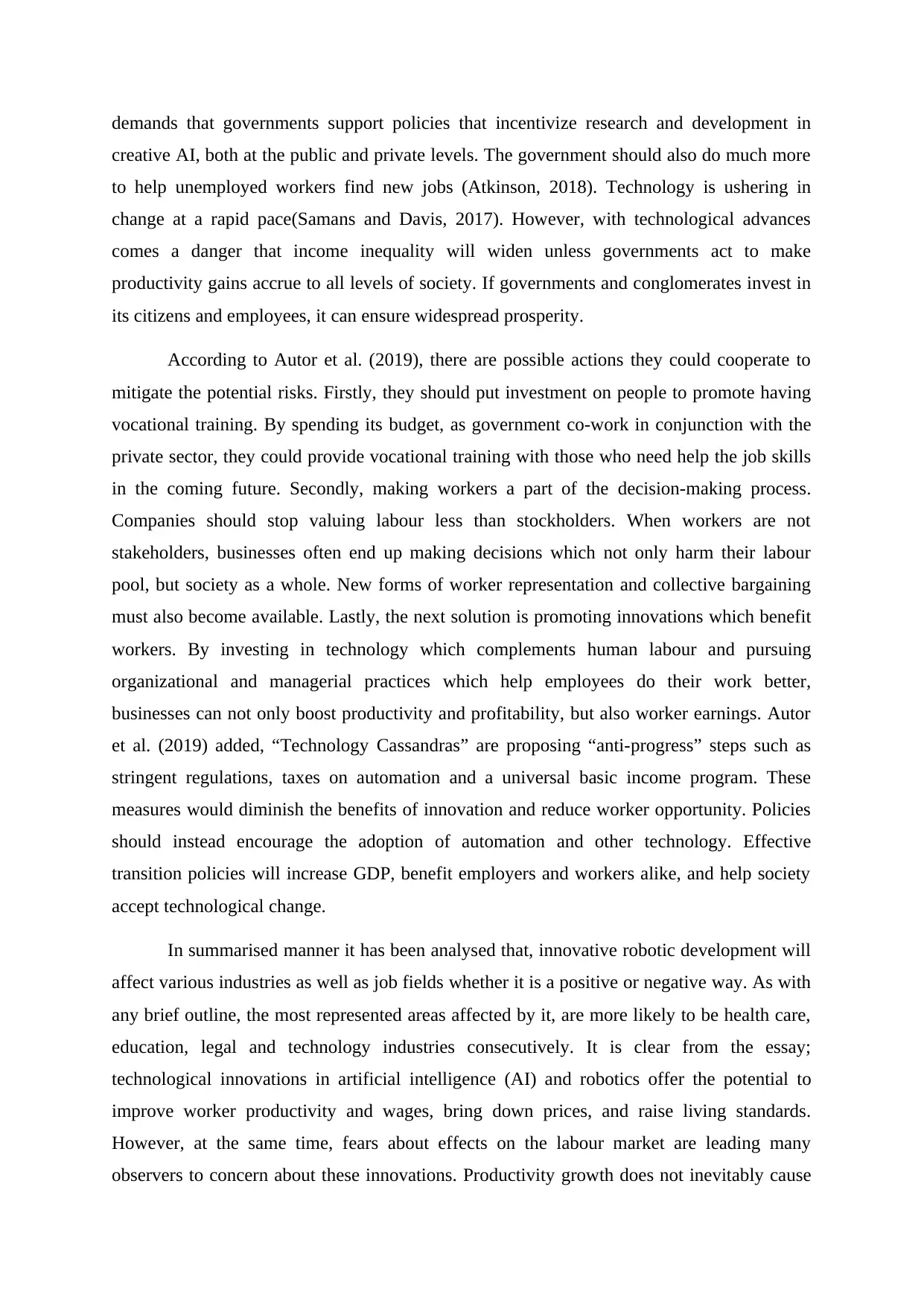
demands that governments support policies that incentivize research and development in
creative AI, both at the public and private levels. The government should also do much more
to help unemployed workers find new jobs (Atkinson, 2018). Technology is ushering in
change at a rapid pace(Samans and Davis, 2017). However, with technological advances
comes a danger that income inequality will widen unless governments act to make
productivity gains accrue to all levels of society. If governments and conglomerates invest in
its citizens and employees, it can ensure widespread prosperity.
According to Autor et al. (2019), there are possible actions they could cooperate to
mitigate the potential risks. Firstly, they should put investment on people to promote having
vocational training. By spending its budget, as government co-work in conjunction with the
private sector, they could provide vocational training with those who need help the job skills
in the coming future. Secondly, making workers a part of the decision-making process.
Companies should stop valuing labour less than stockholders. When workers are not
stakeholders, businesses often end up making decisions which not only harm their labour
pool, but society as a whole. New forms of worker representation and collective bargaining
must also become available. Lastly, the next solution is promoting innovations which benefit
workers. By investing in technology which complements human labour and pursuing
organizational and managerial practices which help employees do their work better,
businesses can not only boost productivity and profitability, but also worker earnings. Autor
et al. (2019) added, “Technology Cassandras” are proposing “anti-progress” steps such as
stringent regulations, taxes on automation and a universal basic income program. These
measures would diminish the benefits of innovation and reduce worker opportunity. Policies
should instead encourage the adoption of automation and other technology. Effective
transition policies will increase GDP, benefit employers and workers alike, and help society
accept technological change.
In summarised manner it has been analysed that, innovative robotic development will
affect various industries as well as job fields whether it is a positive or negative way. As with
any brief outline, the most represented areas affected by it, are more likely to be health care,
education, legal and technology industries consecutively. It is clear from the essay;
technological innovations in artificial intelligence (AI) and robotics offer the potential to
improve worker productivity and wages, bring down prices, and raise living standards.
However, at the same time, fears about effects on the labour market are leading many
observers to concern about these innovations. Productivity growth does not inevitably cause
creative AI, both at the public and private levels. The government should also do much more
to help unemployed workers find new jobs (Atkinson, 2018). Technology is ushering in
change at a rapid pace(Samans and Davis, 2017). However, with technological advances
comes a danger that income inequality will widen unless governments act to make
productivity gains accrue to all levels of society. If governments and conglomerates invest in
its citizens and employees, it can ensure widespread prosperity.
According to Autor et al. (2019), there are possible actions they could cooperate to
mitigate the potential risks. Firstly, they should put investment on people to promote having
vocational training. By spending its budget, as government co-work in conjunction with the
private sector, they could provide vocational training with those who need help the job skills
in the coming future. Secondly, making workers a part of the decision-making process.
Companies should stop valuing labour less than stockholders. When workers are not
stakeholders, businesses often end up making decisions which not only harm their labour
pool, but society as a whole. New forms of worker representation and collective bargaining
must also become available. Lastly, the next solution is promoting innovations which benefit
workers. By investing in technology which complements human labour and pursuing
organizational and managerial practices which help employees do their work better,
businesses can not only boost productivity and profitability, but also worker earnings. Autor
et al. (2019) added, “Technology Cassandras” are proposing “anti-progress” steps such as
stringent regulations, taxes on automation and a universal basic income program. These
measures would diminish the benefits of innovation and reduce worker opportunity. Policies
should instead encourage the adoption of automation and other technology. Effective
transition policies will increase GDP, benefit employers and workers alike, and help society
accept technological change.
In summarised manner it has been analysed that, innovative robotic development will
affect various industries as well as job fields whether it is a positive or negative way. As with
any brief outline, the most represented areas affected by it, are more likely to be health care,
education, legal and technology industries consecutively. It is clear from the essay;
technological innovations in artificial intelligence (AI) and robotics offer the potential to
improve worker productivity and wages, bring down prices, and raise living standards.
However, at the same time, fears about effects on the labour market are leading many
observers to concern about these innovations. Productivity growth does not inevitably cause

higher unemployment; it reduces production costs and makes lower prices and higher wages
possible. This innovation will probably not disrupt the economy or workplace any more
drastically than previous cases did. Fears of AI replacing humans across the board exaggerate
progress in AI, and pessimistic estimates of the pace of change arouse needless fears.
Although some problems still remain same for that major action has to be taken and positive
changes related the same will obtain and better outcomes company will gain with the
assistance of robotic technology.
possible. This innovation will probably not disrupt the economy or workplace any more
drastically than previous cases did. Fears of AI replacing humans across the board exaggerate
progress in AI, and pessimistic estimates of the pace of change arouse needless fears.
Although some problems still remain same for that major action has to be taken and positive
changes related the same will obtain and better outcomes company will gain with the
assistance of robotic technology.
You're viewing a preview
Unlock full access by subscribing today!
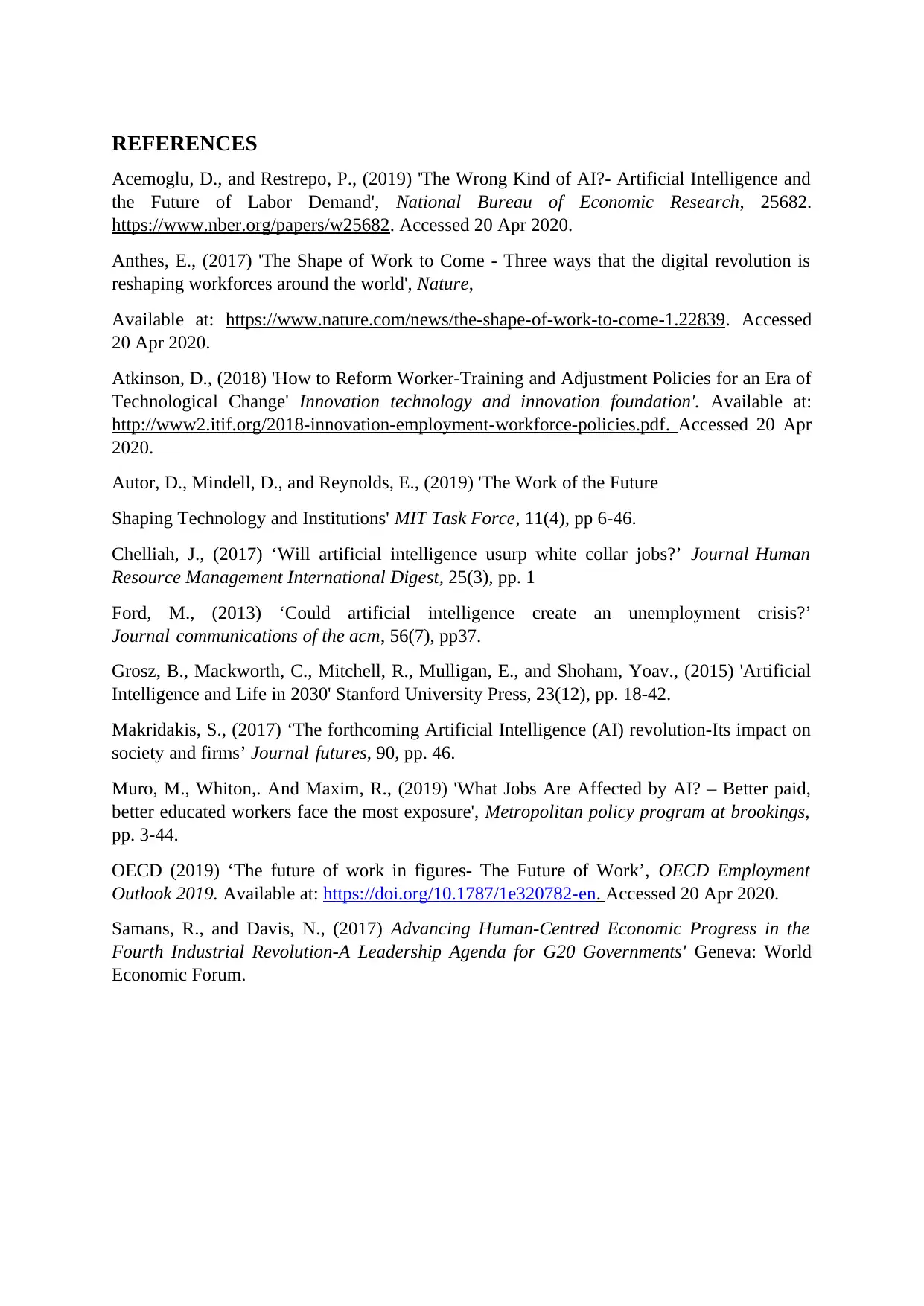
REFERENCES
Acemoglu, D., and Restrepo, P., (2019) 'The Wrong Kind of AI?- Artificial Intelligence and
the Future of Labor Demand', National Bureau of Economic Research, 25682.
https://www.nber.org/papers/w25682. Accessed 20 Apr 2020.
Anthes, E., (2017) 'The Shape of Work to Come - Three ways that the digital revolution is
reshaping workforces around the world', Nature,
Available at: https://www.nature.com/news/the-shape-of-work-to-come-1.22839. Accessed
20 Apr 2020.
Atkinson, D., (2018) 'How to Reform Worker-Training and Adjustment Policies for an Era of
Technological Change' Innovation technology and innovation foundation'. Available at:
http://www2.itif.org/2018-innovation-employment-workforce-policies.pdf. Accessed 20 Apr
2020.
Autor, D., Mindell, D., and Reynolds, E., (2019) 'The Work of the Future
Shaping Technology and Institutions' MIT Task Force, 11(4), pp 6-46.
Chelliah, J., (2017) ‘Will artificial intelligence usurp white collar jobs?’ Journal Human
Resource Management International Digest, 25(3), pp. 1
Ford, M., (2013) ‘Could artificial intelligence create an unemployment crisis?’
Journal communications of the acm, 56(7), pp37.
Grosz, B., Mackworth, C., Mitchell, R., Mulligan, E., and Shoham, Yoav., (2015) 'Artificial
Intelligence and Life in 2030' Stanford University Press, 23(12), pp. 18-42.
Makridakis, S., (2017) ‘The forthcoming Artificial Intelligence (AI) revolution-Its impact on
society and firms’ Journal futures, 90, pp. 46.
Muro, M., Whiton,. And Maxim, R., (2019) 'What Jobs Are Affected by AI? – Better paid,
better educated workers face the most exposure', Metropolitan policy program at brookings,
pp. 3-44.
OECD (2019) ‘The future of work in figures- The Future of Work’, OECD Employment
Outlook 2019. Available at: https://doi.org/10.1787/1e320782-en. Accessed 20 Apr 2020.
Samans, R., and Davis, N., (2017) Advancing Human-Centred Economic Progress in the
Fourth Industrial Revolution-A Leadership Agenda for G20 Governments' Geneva: World
Economic Forum.
Acemoglu, D., and Restrepo, P., (2019) 'The Wrong Kind of AI?- Artificial Intelligence and
the Future of Labor Demand', National Bureau of Economic Research, 25682.
https://www.nber.org/papers/w25682. Accessed 20 Apr 2020.
Anthes, E., (2017) 'The Shape of Work to Come - Three ways that the digital revolution is
reshaping workforces around the world', Nature,
Available at: https://www.nature.com/news/the-shape-of-work-to-come-1.22839. Accessed
20 Apr 2020.
Atkinson, D., (2018) 'How to Reform Worker-Training and Adjustment Policies for an Era of
Technological Change' Innovation technology and innovation foundation'. Available at:
http://www2.itif.org/2018-innovation-employment-workforce-policies.pdf. Accessed 20 Apr
2020.
Autor, D., Mindell, D., and Reynolds, E., (2019) 'The Work of the Future
Shaping Technology and Institutions' MIT Task Force, 11(4), pp 6-46.
Chelliah, J., (2017) ‘Will artificial intelligence usurp white collar jobs?’ Journal Human
Resource Management International Digest, 25(3), pp. 1
Ford, M., (2013) ‘Could artificial intelligence create an unemployment crisis?’
Journal communications of the acm, 56(7), pp37.
Grosz, B., Mackworth, C., Mitchell, R., Mulligan, E., and Shoham, Yoav., (2015) 'Artificial
Intelligence and Life in 2030' Stanford University Press, 23(12), pp. 18-42.
Makridakis, S., (2017) ‘The forthcoming Artificial Intelligence (AI) revolution-Its impact on
society and firms’ Journal futures, 90, pp. 46.
Muro, M., Whiton,. And Maxim, R., (2019) 'What Jobs Are Affected by AI? – Better paid,
better educated workers face the most exposure', Metropolitan policy program at brookings,
pp. 3-44.
OECD (2019) ‘The future of work in figures- The Future of Work’, OECD Employment
Outlook 2019. Available at: https://doi.org/10.1787/1e320782-en. Accessed 20 Apr 2020.
Samans, R., and Davis, N., (2017) Advancing Human-Centred Economic Progress in the
Fourth Industrial Revolution-A Leadership Agenda for G20 Governments' Geneva: World
Economic Forum.
1 out of 10
Related Documents
Your All-in-One AI-Powered Toolkit for Academic Success.
+13062052269
info@desklib.com
Available 24*7 on WhatsApp / Email
![[object Object]](/_next/static/media/star-bottom.7253800d.svg)
Unlock your academic potential
© 2024 | Zucol Services PVT LTD | All rights reserved.





